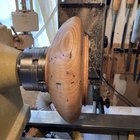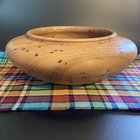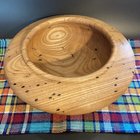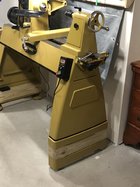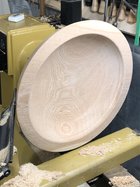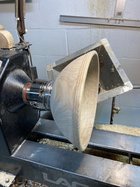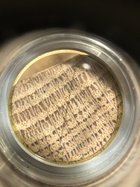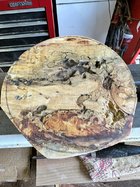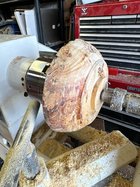The ash blank that I just turned this bowl from has been on the shelf drying for about two years. I wish it didn’t have the bug tunnels, but some folks seem to actually prefer the “character” they impart to a piece of Un-buggy wood. Go figure! The bowl is 11 1/2” diameter by 4” tall.
-
April 2025 Turning Challenge: Turn an Egg! (click here for details) -
Congratulations to Kelly Shaw winner of the March 2025 Turning Challenge (click here for details) -
Congratulations to Ellen Starr for "Lotus Temple" being selected as Turning of the Week for 21 April, 2025 (click here for details) -
Welcome new registering member. Your username must be your real First and Last name (for example: John Doe). "Screen names" and "handles" are not allowed and your registration will be deleted if you don't use your real name. Also, do not use all caps nor all lower case.
You are using an out of date browser. It may not display this or other websites correctly.
You should upgrade or use an alternative browser.
You should upgrade or use an alternative browser.
What’s on your lathe?
- Thread starter Rusty Nesmith
- Start date
Michigan State Spartans!!!!!Is that a USC Trojan logo?
Hopefully you have some of the bark left to pulverize and fill the crotch and bark inclusions that are missing some of it, a blender would make quick work of a small chunk of bark, CA soak will keep it in place, so far so goodFinished the exterior and hollowing the interior of the Torreya calabash. Tomorrow I’ll sand the interior and work on fixing some cracks and other things. The light at the end of the tunnel is finally visible. Whew!
View attachment 52185
Thank you! That’s a great idea about the pulverized bark. Didn’t even cross my mind.Hopefully you have some of the bark left to pulverize and fill the crotch and bark inclusions that are missing some of it, a blender would make quick work of a small chunk of bark, CA soak will keep it in place, so far so good View attachment 52195
Last edited:
Well............................two things.
I'm in no way ever going to be confused with a painter!
Plus if you get to close to a spinning chunk of wood with a sharp object you just may take a big chunk out of your work and have to start over!!
My humble 3rd rendition of a light house. Tried to make it look old and weathered.

I'm in no way ever going to be confused with a painter!
Plus if you get to close to a spinning chunk of wood with a sharp object you just may take a big chunk out of your work and have to start over!!
My humble 3rd rendition of a light house. Tried to make it look old and weathered.

Mike,
Also from your pic, you have the machine feet sitting on blocks of wood. Can't see if that block is recessed for the foot to sit into or not but even if it is, don't believe it's the best set-up especially if you plan on doing big out of round pieces alot. If one of those feet ever vibrates out, you’re going to be trying to catch 700+ pounds of machine from tipping over........don't ask how I know. Here's what I did to a previous machine that I needed to jack up in the air.
Dave
I took your observation to heart. I used an old landscape timber, cut it to size, and bolted it between the leg and the PM riser using 3/8 x 7 bolts. Not only is it safer but it’s more stable too.
I was surprised to find that the bolts PM uses for the feet and leg extension is an oddball size 1/-12. That’s why I used 3/8 thru bolts instead.
Attachments
I use a small coffee grinder for that and wood chips.a blender would make quick work of a small chunk of bark
Very nice modification Mike.Dave
I took your observation to heart. I used an old landscape timber, cut it to size, and bolted it between the leg and the PM riser using 3/8 x 7 bolts. Not only is it safer but it’s more stable too.
I was surprised to find that the bolts PM uses for the feet and leg extension is an oddball size 1/-12. That’s why I used 3/8 thru bolts instead.
My wife drinks tea that she buys in bulk. I have tried some used tea leaves from the strainer in a grinder. I like that there are a variety of colors and it is natural. I would imagine that adding a bit of the bark would create a very nice filler matieral.That’s what I ended up doing. I added a few coffee beans to the bark to darken the fill a bit.
View attachment 52211
Todays task on this never ending Torreya project is to repair and/or mitigate the cracks. I’m using a variety of techniques. In this case, pewa/butterflies/dutchmen for the more serious/cluttered areas. Other areas are getting other types of repairs.

Apologies if it seems like I’m spamming this thread with my progress photos. It’s an effective way to keep me motivated during this bowl project.

Apologies if it seems like I’m spamming this thread with my progress photos. It’s an effective way to keep me motivated during this bowl project.
Michael, we/I like pictures of what different turners do with/on their pieces, it also keeps the forum "alive", I have used staples that I made, to keep splits from opening more, or preventing from happening.Todays task on this never ending Torreya project is to repair and/or mitigate the cracks. I’m using a variety of techniques. In this case, pewa/butterflies/dutchmen for the more serious/cluttered areas. Other areas are getting other types of repairs.
View attachment 52213
Apologies if it seems like I’m spamming this thread with my progress photos. It’s an effective way to keep me motivated during this bowl project.
Some of the staples got relocated after finish turning in a obscure location, but the important part is that they do work well.




Last edited:
Thanks, Leo. I always appreciate the example photos. I’ve used staples a handful of times, salvaged from copper wire or coat hanger wire. Here’s the most recent:

Very effective method for keeping cracks from opening. For this one I wanted to stick with wooden repairs. Partly for the challenge, partly for practice, partly for tradition, and partly just for fun

Very effective method for keeping cracks from opening. For this one I wanted to stick with wooden repairs. Partly for the challenge, partly for practice, partly for tradition, and partly just for fun
Nope. Michigan State Spartans!Is that a USC Trojan logo?
Ha! This is just an old coffee grinder we occasionally use to grind spices, so she was alright with it. Ask me what she thought about roasting wood in the oven though…Hey Michael, what's your wife say about using the blender for wood bark.
I have a couple apple roughouts I froze them and now in the garage refrigerator to experiment with drying them. So far she either hasn't notice them or it doesn't bother her.
That looks a lot more like red oak.Another large white oak bowl roughed out.
That looks a lot more like red oak.
Don
I was taking the tree guy’s opinion. I’m no expert. No leaves on it when it came down. Here is a close up of end grain. What do you think?
Attachments
Mike, that is absolutely White Oak.
This will likely be the last progress photo of the Torreya calabash I’m working on. Yesterday, I managed to inlay 6 Walnut pewa. Today’s task is to add a few small Wenge pewa and a couple of Mahogany poho patches to some weak endgrain. I think that will complete all the inlays. Tomorrow, I hope to do my final sanding and start the finishing process. Here is the final layout before I start cutting into the bowl.


Last edited:
Neat idea Michael. How do you cut the pockets for the patches/Dutchman? By hand? or router with a jig?This will likely be the last progress photo of the Torreya calabash I’m working on. Yesterday, I managed to inlay 6 Walnut pewa. Today’s task is to add a few small Wenge pewa and a couple of Mahogany poho patches to some weak endgrain. I think that will complete all the inlays. Tomorrow, I hope to do my final sanding start the finishing process. Here is the final layout before I start cutting into the bowl.
View attachment 52244
Be safe and stay well.
Barry W. Larson
Calgary, Alberta, Canada eh!
Heya Barry! For a couple of the larger Dutchmen I used a router and jig from Slabstitcher. It’s meant for flatwork, so it took some finagling to get the angles right. For the other ones, I’ve been hogging out the majority with a palm router, and then use a chisel to clean up the edges and corners. The problem with this method is the router follows the contour of the bowl, which means I need to sand away the same profile in the back of each inlay. The benefit of the jig is that it cuts in one plane, so I can just inlay the patch the same way I would with flatwork.
Thanks Michael. I like the effect, so I'll be doing some experimenting. I built a jig for flatwork some time ago; from you comment I just need to experiment in applying it to round work! If you have some pictures of your jig in use they would be appreciated.Heya Barry! For a couple of the larger Dutchmen I used a router and jig from Slabstitcher. It’s meant for flatwork, so it took some finagling to get the angles right. For the other ones, I’ve been hogging out the majority with a palm router, and then use a chisel to clean up the edges and corners. The problem with this method is the router follows the contour of the bowl, which means I need to sand away the same profile in the back of each inlay. The benefit of the jig is that it cuts in one plane, so I can just inlay the patch the same way I would with flatwork.
Be safe and stay well.
Barry
I thought I had taken a photo during the process, but I guess not. Here’s a photo of the removed template that shows some shims I taped to the backside. This stabilized the jig so that it sat on a tangent to the bowl’s curve. I then taped it to the bowl itself so it wouldn’t move around during routing.


Nice, Monty. That form is looking great so far. I haven’t heard of Obeche before. Thanks for the link. It almost looks like a light colored Mahogany.
The wood came from English Woods in a "selection box" with some other woods that are uncommon here. Cost of the wood was reasonable and the quality was excellent, but shipping was egregious.Nice, Monty. That form is looking great so far. I haven’t heard of Obeche before. Thanks for the link. It almost looks like a light colored Mahogany.
Last edited:
Perfect! Thanks Michael. Useful stuff that blue tape!I thought I had taken a photo during the process, but I guess not. Here’s a photo of the removed template that shows some shims I taped to the backside. This stabilized the jig so that it sat on a tangent to the bowl’s curve. I then taped it to the bowl itself so it wouldn’t move around during routing.
View attachment 52248
Be safe and stay well.
Barry

